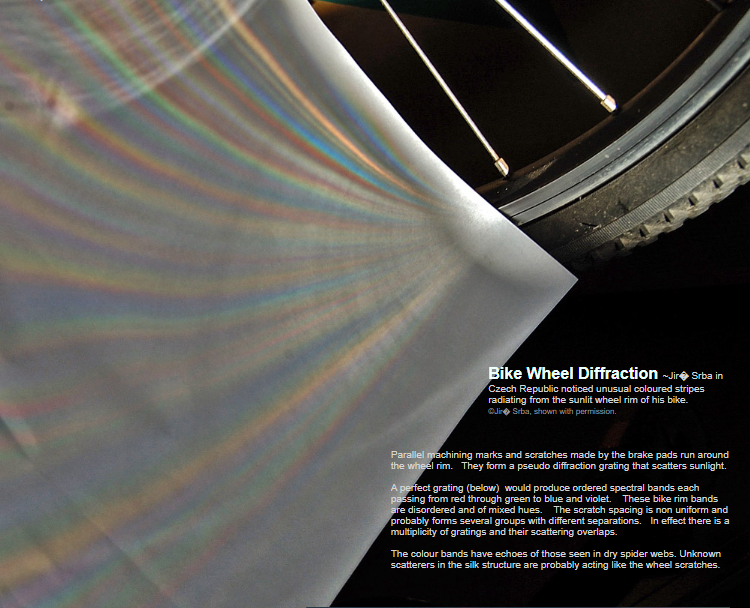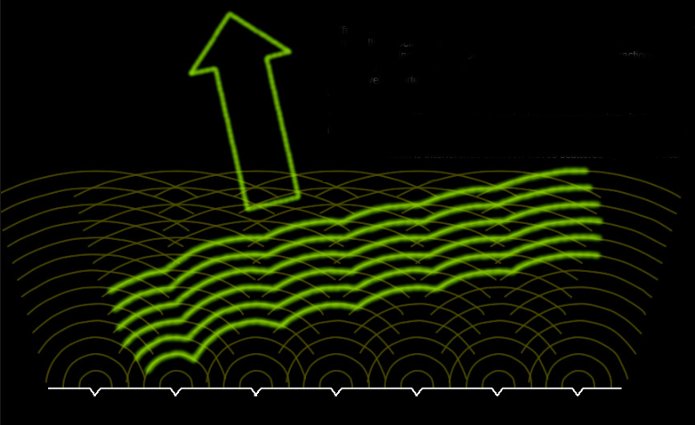OPOD - Of Bicycles & Spiders
OPOD - Of Bicycles & Spiders: Exploring the Phenomenon of Diffraction
Have you ever noticed unusual colored stripes radiating from the sunlit wheel rim of a bicycle? This intriguing phenomenon, known as bike wheel diffraction, has caught the attention of many observers. Jirí Srba, a keen observer from the Czech Republic, captured these captivating bands of colors on his bike wheel.
The source of these colorful bands lies in the parallel machining marks and scratches made by the brake pads that run around the wheel rim. These marks unintentionally form a pseudo diffraction grating, scattering sunlight and creating a mesmerizing display. While a perfect grating would produce ordered spectral bands ranging from red through green to blue and violet, the bike rim bands appear disordered and exhibit mixed hues. This is due to the non-uniform spacing of the scratches, which likely form several groups with different separations. As a result, multiple gratings are formed, and their scattering overlaps, leading to a complex and beautiful display of colors.
Interestingly, the color bands observed on bike rims bear a resemblance to those seen in dry spider webs. Spider webs exhibit their own form of diffraction, which can produce similar patterns. The unknown scatterers within the silk structure of spider webs likely act similarly to the wheel scratches, contributing to the creation of these colorful bands. It is believed that certain elements within the silk structure of spider webs scatter light in a way that resembles the effect of the scratches on a bike wheel.
Diffraction is a phenomenon that occurs when light encounters an obstacle or aperture with dimensions comparable to its wavelength. In the case of the bike wheel diffraction and spider web diffraction, the scratches on the bike rim and the structural elements of the spider web act as obstacles that cause light to diffract. When parallel light illuminates a grating composed of equally spaced scratches or grooves, scattered cylindrical waves radiate out from each scratch. As these waves propagate away from the grating, they eventually overlap and interfere with each other. This interference creates regions where the wave crests are in phase, resulting in an outgoing plane wavefront. In other regions, the waves destructively interfere. The resulting pattern depends on the wavelength of light, and when white light is incident on the grating, it produces a spectrum of colors.
It is important to note that the scattering observed in diffraction is different from that producing a corona or glory. In phenomena like coronas and glories, the complete interference pattern is produced by waves radiating from individual drops of water. However, in the case of diffraction, the interference occurs between waves scattered by a macro-scale structured array of individual scatterers, such as the scratches on a bike rim or the elements within a spider web.
To further explore spider web diffraction, Ágnes Őri from Hungary captured a captivating image of diffraction in a spider web. To better visualize the colors, the silk of the web was deliberately defocused. The colored bands observed in the image are likely produced by bulges of viscous fluid within the silk structure. These bulges confer extreme elasticity to the silk, allowing it to coil and uncoil, and also make it sticky enough to trap insects. The precise mechanism behind the generation of these colorful bands in spider webs is still not fully understood and remains an area of ongoing research.
In conclusion, the captivating phenomenon of diffraction can be observed in various natural and man-made structures, such as bike rims and spider webs. The parallel machining marks and scratches on a bike rim act as a pseudo diffraction grating, scattering sunlight and creating disordered bands of mixed hues. Similarly, spider webs exhibit their own form of diffraction due to unknown scatterers within the silk structure. Understanding these phenomena adds to our appreciation of the intricate interactions between light and matter in the natural world.

Bike Wheel Diffraction ~Jir� Srba in Czech Republic noticed unusual coloured stripes radiating from the sunlit wheel rim of his bike.
©Jir� Srba, shown with permission.
Parallel machining marks and scratches made by the brake pads run around the wheel rim. They form a pseudo diffraction grating that scatters sunlight.
A perfect grating (below) would produce ordered spectral bands each passing from red through green to blue and violet. These bike rim bands are disordered and of mixed hues. The scratch spacing is non uniform and probably forms several groups with different separations. In effect there is a multiplicity of gratings and their scattering overlaps.
The colour bands have echoes of those seen in dry spider webs. Unknown scatterers in the silk structure are probably acting like the wheel scratches.

Diffraction by a grating of equally spaced scratches (or grooves or wires) illuminated by parallel light. Scattered cylindrical waves radiate out from each scratch. Some distance from the grating the individual outgoing waves overlap. In certain directions the wave crests are in phase and they eventually combine to an outgoing plane wavefront. Elsewhere the waves destructively interfere. The outgoing wave direction depends on wavelength and thus with incident white light the grating produces a spectrum.
The scattering is different from that producing a corona or glory. In those the complete interference pattern is produced by waves radiating from just one drop. The light from millions of randomly positioned drops give a corona by simple addition rather than any interference. Grating diffraction is interference between waves scattered by a macro scale structured array of individual scatterers..

Spider Web Diffraction imaged by Ágnes Őri in Hungary. The web silk was deliberately defocused to better show the colours. The coloured bands are likely produced by bulges of viscous fluid that confer extreme elasticity by coiling and uncoiling the silk and, by being sticky, trap insects. ©Ágnes Őri , shown with permission.
Note: this article has been automatically converted from the old site and may not appear as intended. You can find the original article here.
Reference Atmospheric Optics
If you use any of the definitions, information, or data presented on Atmospheric Optics, please copy the link or reference below to properly credit us as the reference source. Thank you!
-
<a href="https://atoptics.co.uk/blog/opod-of-bicycles-spiders/">OPOD - Of Bicycles & Spiders</a>
-
"OPOD - Of Bicycles & Spiders". Atmospheric Optics. Accessed on April 16, 2024. https://atoptics.co.uk/blog/opod-of-bicycles-spiders/.
-
"OPOD - Of Bicycles & Spiders". Atmospheric Optics, https://atoptics.co.uk/blog/opod-of-bicycles-spiders/. Accessed 16 April, 2024
-
OPOD - Of Bicycles & Spiders. Atmospheric Optics. Retrieved from https://atoptics.co.uk/blog/opod-of-bicycles-spiders/.